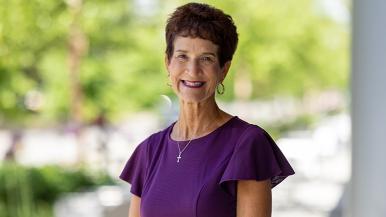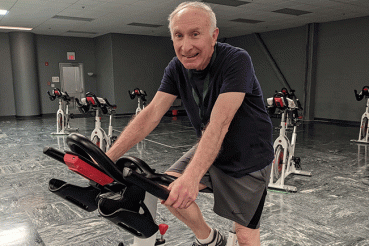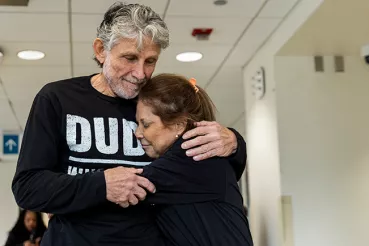Lorayne Wright was the image of "perfect health" — she exercised regularly and ate a healthy diet. But after dinner one night in March of 2022, she knew something was wrong.
“I had gone out with some friends and ordered fried fish, which wasn’t normal for me,” says Lorayne, who lives in Shorewood, Illinois. “I didn’t feel well the next day, but I just thought it was food poisoning.”
When the pain in her abdomen didn’t get better, Lorayne went to an immediate care center that prescribed medication for a stomachache. But the pain continued the following week, so she made an appointment with her primary care doctor.
“I walked in, and my doctor said I didn’t look good,” Lorayne says. “She ordered blood work right away because I was a little jaundiced, and she suspected hepatitis.”
The results showed Lorayne had elevated liver enzymes. This prompted her doctors to order a CT scan, which revealed a suspicious spot on her pancreas.
The team at Rush stepped in to help
Lorayne’s doctor contacted Sam Pappas, MD, a surgical oncologist at RUSH MD Anderson Cancer Center, who evaluated Lorayne a few days later.
“The combination of symptoms Lorayne was experiencing can be early, subtle signs that something’s wrong in the pancreas, especially since she was otherwise healthy,” Pappas says.
Pappas ordered a biopsy and referred Lorayne to Ajaypal Singh, MD, an interventional gastroenterologist at RUSH MD Anderson. Singh performed the biopsy, which showed Lorayne’s diagnosis of pancreatic cancer, located on the right side of her pancreas.
“I was completely shocked,” Lorayne says. “It blindsided me and my husband John. I couldn’t believe this was happening.”
Lorayne’s case was brought to the tumor board — a collaborative group of specialists — to create an approach for treating her pancreatic cancer. Together, they decided that chemotherapy and radiation would be best to start with, to help shrink her tumor before considering surgery.
Lorayne was then referred to William Leslie, MD, a medical oncologist at RUSH MD Anderson. Lorayne received three months of chemotherapy followed by chemotherapy with radiation before her surgery.
“On my first day of chemo, that’s when I saw the bell that patients ring at the end of their treatment,” says Lorayne, who started her first round in April 2022 at Rush University Medical Center. “I said to John, ‘Someday, that’ll be me ringing that bell.’”
In July, Lorayne started radiation treatment after meeting with Thomas Kim, MD, a radiation oncologist at RUSH MD Anderson. She completed 28 treatments over five weeks at Rush Copley Medical Center, which was closer to her home.
The Whipple procedure
After Lorayne finished her treatments, she met with Pappas’ partner and colleague Matt Dixon, MD, another surgical oncologist at RUSH MD Anderson.
“We saw a nice response to the treatments on Lorayne’s CT scans,” Dixon says. “The tumor had shrunk enough that we thought she would be a good candidate for surgery to remove her pancreatic cancer.”
Pappas and Dixon recommended the Whipple procedure, which involves removing the right half of the pancreas and tumor, along with lymph nodes and other abdominal organs next to the pancreas.
“There are multiple different types of surgical procedures that can be done to treat pancreatic cancer,” Pappas says. “But Lorayne’s tumor was on the right side of her pancreas, so we suggested the Whipple procedure. It can be challenging, but we wanted to preserve the left side of her pancreas.”
Lorayne was hesitant about surgery, but she had confidence in her doctors.
“I had no idea what the Whipple surgery was — I had never heard of it,” Lorayne says. “It was very scary, but I trusted my surgeons.”

On Oct. 21, Dixon removed the stage one tumor on Lorayne’s pancreas during the Whipple procedure.
“Lorayne was so strong and brave — and it really showed,” Dixon says. “We are really happy that she had trusted us and that everything went really well.”
Since the Whipple procedure, Lorayne has had no evidence of the disease.
Celebrating life
Lorayne underwent a final round of chemotherapy, finishing on March 20, 2023, in the just-opened Joan and Paul Rubschlager Building.
“This whole time my goal was to ring the bell after I was done with treatment,” she says. “But the bell hadn’t been brought over from the old building, so I didn’t think I’d be able to do it.”
After her final treatment, Lorayne’s care team said they had a surprise — there was a bell for her to ring that John had donated to the infusion center.
“I was more in shock than anything — and there were a lot of tears everywhere,” Lorayne says. “I couldn’t believe John had done this. It was very overwhelming.”

Lorayne is doing well and is enjoying time with her family. She periodically has checkups with Leslie and Anita Sharko, NP, at Rush Oak Park Hospital.
“This experience has helped me truly appreciate each day,” she says. “None of us knows if or when we're going to get cancer. If I had blown off my stomachache — and without the support of my care team — I wouldn't be here today.”
Lorayne spoke at Rush’s annual Cancer Survivors Day event this year. For more information on cancer care at RUSH MD Anderson Cancer Center, visit us online.




